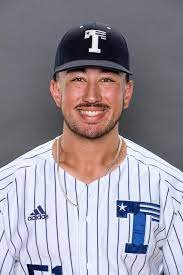Canadian Yamaguchi looking to star in Japan
Two-way player A.J. Yamaguchi (Vancouver, B.C.), shown here with the UT Tyler Patriots, was drafted by the NPB’s Hokkaido Nippon-Ham Fighters this year.
December 19, 2022
By Evan Christie
Canadian Baseball Network
For some reason or another, if you’re a Canadian playing in Japan, you play for the Nippon-Ham Fighters.
The first Canadian to ever play in NPB, was Edward Yoshie (Vancouver, BC) was the first Canadian to pitch in Japan, going 16-19 with a 3.14 ERA for the 1948 Kyuei Flyers.
Then came Bob Alexander (Vancouver, B.C.),, who played for Nippon Ham in 1959, when they were still called the Toei Flyers. In the 90s, Rob Ducey (Cambridge, Ont.) and Nigel Wilson (Oshawa, Ont.) joined the team and excelled.
Ducey’s short stint with the team was highlighted by elite production. In 1995 and 1996, he put up a wRC+ of 140, and 10.5 WAR as he backed up Fighters legend Michihiro Ogasawara on a team that battled Ichiro’s Orix BlueWave all the way in 1996, but eventually had to settle for second.
Wilson joined the team immediately after Ducey left and won two Pacific League Home Run King awards in 1997 and 1998. He also led the PL in RBIs in 1998. Wilson picked up two Best 9 Awards as the best DH in the Pacific League in 1998 and 2000, and his five seasons with the club ties him with Jack Ladra for the longest tenure by any foreign Fighter.
Since then though, the only Canadian Fighter has been Dustin Molleken (Regina, Sask.), who spent two years as a reliever with the club in 2012 and 2013. Other Canadians have since had success elsewhere.
Aaron Guiel (Vancouver, B.C.) spent five seasons with the Tokyo Yakult Swallows, while an elite hitter when healthy… the problem was that he wasn’t always healthy. Scott Mathieson (Aldergrove, B.C.) was the closer for the legendary Yomiuri Giants from 2012 to 2019, and is the only Canadian to have won a Japan Series ring, which he did in 2012. And finally Andrew Albers (North Battleford, Sask.) spent a few seasons as a serviceable reliever for the Orix Buffaloes, but no Canadian has suited up for an NPB club since 2020.
A.J. Yamaguchi hopes to change that.
The Hokkaido Nippon-Ham Fighters decided to have an interesting draft in 2022. They became the first team to select a player from an MLB organization, grabbing former Toronto Blue Jay Gosuke Katoh from the Mets in the third round, and they also grabbed Yamaguchi in the third round of the subsequent development draft.
But just who is A.J. Yamaguchi?
Born in Vancouver in 1999 to a Japanese father, Taku, and a Greek-Canadian mother, Margaret, Ataru Jay Yamaguchi began playing baseball at the age of 8.
As a pitcher and an infielder, he quickly rose to prominence as his Little League team represented Canada at the 2012 Little League World Series in Williamsport. Also playing in that tournament was current Fighters first baseman Kotaro Kiyomiya, although Canada and Japan never played against each other, so the two never faced off.
Yamaguchi grew up idolizing former Fighters pitcher Yu Darvish, and visited his grandmother in Osaka every couple of years, where he found himself rooting for NPB’s lovable losers, the Hanshin Tigers.
Yamaguchi would play JuCo ball at Colby College in Kansas, where he excelled as a two-way player. He could reach 95 mph with his fastball and recorded an average exit velocity of 108 mph. After not courting any interest from MLB teams and getting Tommy-John surgery, Yamaguchi decided that he would take a leap.
He would film a recruiting tape showcasing his skills and email it to all 12 NPB clubs ahead of the 2022 draft. Apparently it worked, and the Fighters took him in the third round of the developmental draft.
But what is the developmental draft?
Well, in NPB there are two drafts, a regular draft and a developmental draft.
NPB teams are limited to having a 70-man roster. In order for a player to play with the major league club, also known as the “ichi-gun” (first army), they need to be on that shortlist of 70. This is also why managers and coaches in Japan typically pick numbers over 70. Players taken in the regular draft, like Gosuke Kato, must be put on the 70-man roster, but players taken in the development draft are not put on the 70-man roster. This means that players like Yamaguchi are limited to minor-league play until they can crack the 70-man.
The path to the 70-man can be rather quick. Pint-sized shortstop Natsuo Takizawa was activated to the Saitama Seibu Lions roster thanks to injuries after being selected in the 2021 draft. Another notable player taken with a developmental pick was current New York Met Kodai Senga. Senga was taken in the 2010 developmental draft and activated to the 70-man roster in 2012.
Players taken in the development draft are also given numbers over 100. When Yamaguchi decided to sign with the Fighters, he was assigned the number 127.
Yamaguchi still has a long road ahead of him. Despite having access to his father’s side of the family, Yamaguchi never really learned Japanese beyond the basics. The way he tells it, he learned more conversational Japanese from watching Japanese comedy troupe Downtown then from books (can relate). He has been learning though, doing so with the help of his father, who prepared his statement for the post-draft conference.
While Yamaguchi probably won’t crack the big-league roster for at least a couple years, he hopes that he finds success when he does.

